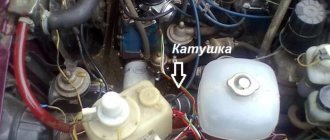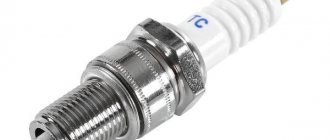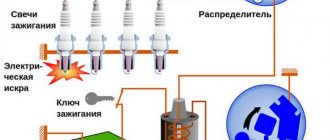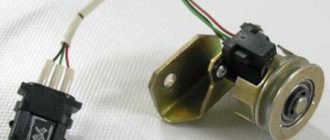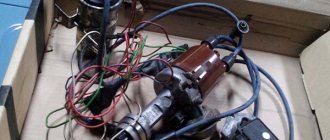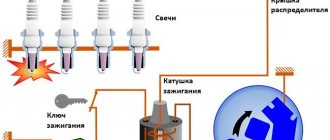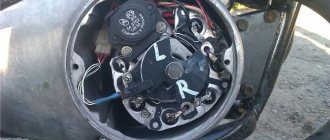Setting the ignition timing with advance
This setup is completely easy to do. Even a beginner can cope with this task. To do this, prepare a 13 mm wrench and a special 38 mm crankshaft wrench in advance.
If your car is started, be sure to turn off the engine, since you can only turn on the ignition when the engine is turned off. First, the piston of the first cylinder is installed at the top dead center of the compression stroke, that is, in the ignition position. Before doing this, remove the candles and plug the hole from them with cotton.
You need to align the mark on the crankshaft and the front engine cover. To do this, use a wrench to start turning the crankshaft clockwise. During this action, the air compressed there should push out the cotton wool, thereby indicating the compression stroke. Continue turning the shaft slowly until the marks on the timing belt pulley and cover line up.
Please note that there are 3 marks on the cover:
- The first indicates ignition advance by 10º;
- the second – by 5 º;
- the third is equal to zero.
Since a VAZ 2107 engine with a carburetor runs on 92 or 95 gasoline, we need to set the ignition for these types of fuel. That is why you should select the second mark, which will indicate an ignition advance of 5º.
Once the required parameters match, put the spark plugs in place and remove the wires. The system is ready for use.
General operating principle
The presence of a contact ignition system in a car means that the ignition of the fuel in the cylinders is carried out upon the appearance of a spark from the spark plug.
In this case, the spark itself occurs when a high voltage pulse arrives from the ignition coil.
The key function is performed by the ignition coil, which, according to its operating principle, resembles a transformer.
It consists of two windings (primary and secondary) wound on a metal core.
First, voltage is applied to the primary winding, after which a current is created in the coil.
As soon as a short-term break in the primary circuit occurs, the magnetic field is leveled, but a high voltage (about 25,000 Volts) appears in the secondary winding.
At this moment, a voltage of 300 Volts is also present on the primary winding.
The reason for its appearance is self-induction currents. It is because of the appearance of this current that the breaker contacts burn and spark.
From the above we can conclude that the secondary voltage directly depends on the following aspects:
- Magnetic field;
- The intensity level of the current drop in the primary winding.
To increase the secondary voltage and reduce the risk of burning the contact group, a capacitor is included in the circuit (installed in parallel). Even with a slight opening, the capacitor is charged.
A schematic diagram of the contact ignition system is shown below.
The capacitance discharge occurs through the primary winding, through the formation of a reverse voltage pulse current. Thanks to this feature, the magnetic field disappears and the secondary voltage increases.
The optimal capacitor capacity for a contact ignition system is 0.17-0.35 µF. For example, domestically produced Zhiguli cars have a capacitor with a capacitance of 0.2-0.25 μF (at a frequency of 50 to 1000 Hz).
If the vehicle's ignition system operates without failure, the secondary voltage should constantly increase. It depends on two main parameters - the size of the gap between the spark plug electrodes, as well as the pressure in the cylinders of the machine.
For a contact ignition system, this parameter (secondary voltage) should be at the level of 8-12 Volts.
In order for the system to operate without failures, at the moment of interruption the mentioned indicator increases to 16-25 kV. The presence of such a reserve allows you to avoid adverse consequences from certain fluctuations in the ignition system.
The problems mentioned above include adjustments to the composition of the combustible mixture or changes in the distance between the spark plug electrodes.
For example, a decrease in the oxygen level in the fuel-combustible mixture leads to an increase in voltage to 20 kV.
Despite a number of measures taken, the creators of the contact ignition system were unable to completely avoid burning the contact group. The optimal way to reduce this effect is to strictly maintain the gap at a minimum level (0.3-0.4 mm).
As an example, we can cite domestic VAZ cars, in which the gap in the breaker is 0.35-0.45 mm, which corresponds to an angle of 52-58 degrees (provided that the contact group is in a closed state).
If this angle changes, the voltage in the secondary winding is also adjusted. As a result, sparks appear not only on the contacts, but also on the sliders. For this reason, the quality of the spark decreases and the engine loses power.
The reliability of the contact ignition system, which depends on a number of factors, deserves special attention:
- Shape, energy and time of spark appearance;
- The number of sparks in a certain area;
- Secondary voltage (one of the most important characteristics). The larger this parameter, the less dependent the system is on the composition of the combustible mixture and the level of cleanliness of the electrodes.
Adjusting the ignition timing
For subsequent actions, use a 13 key to loosen the fastening nut of the distributor (ignition distributor). Connect one wire from the light bulb (it will act as a voltmeter, that is, indicate the presence of voltage) to the low-voltage terminal that the coil has, the second to ground.
Now turn on the ignition. Slowly and carefully rotate the distributor body clockwise, stopping immediately when the light goes out. The sparks that appear will indicate the moment of ignition. Move the distributor counterclockwise until the contacts are disconnected and the lamp lights up again. Everything is in order, you can safely tighten the distributor, the setup is complete.
Installation of electronic ignition
Electronic ignition makes engine operation smoother and softer, makes it easier to start in the winter, and reduces fuel consumption. If you, having a carburetor engine, decide to switch to contactless (electronic) ignition, we will tell you how to correctly install it on a VAZ 2107 car.
An electronic system for a car with a carburetor should not be too expensive or cheap. It is best to opt for a product in the mid-price category, so that later you don’t have to change anything after a while.
Before work, prepare a drill and a set of keys.
For an overview, first read the included instructions carefully and open the carburetor type engine kit. It includes:
- ignition coil;
- distributor;
- switch;
- 4 candles;
- connecting and high-voltage wires.
The system is easy to install. First of all, remove the negative terminal from the battery and turn the crankshaft until marks numbered 3 and 4 align, that is, the highest dead center.
Now you can begin the main steps. The coil should be disconnected from all wires, remove it and install a new one. The coil can now be connected to the central high voltage wire. Connect 2 brown wires to contact “K”, and 2 blue wires to contact “B”.
Now remove the distributor cover. Please note that the slider must be set exactly as shown in the picture. Mark this place with a marker on the block to correctly install the new distributor. Now you can unscrew this part and put it to the side.
After opening the cover of the new distributor, place the slider perpendicular to the engine and insert it into the hole in the cylinder block. Align it with the mark on the block. Next, put on the cover and connect the wires.
Decide where the switch will be located, since there is no space for it in the VAZ 2107 car. We recommend installing it next to the washer reservoir. Secure it with self-tapping screws and install the connector.
Don't forget the candles. To replace them on a VAZ 2107 car, you will need a spark plug wrench, which you should use to unscrew the old spark plugs from the cylinders and put new ones in place.
What does the BSZ consist of?
Contactless ignition includes a small number of parts, thereby reducing the likelihood of failure of each of them. The system consists of:
- Power supply. In all cars it is the battery.
- Ignition and starter switch. The part is necessary for the correct distribution of operating time of the device.
- Ignition coil. Converts low-voltage current from the battery into high-voltage, which ensures stable operation of the car.
- Transistor switch. Responsible for interrupting the flow of electrical current to the coil.
- Ignition sensor. Detects changes in the magnetic field.
- Distribution sensor. The sensor is combined with a pulse sensor, which comes in several types. The pulse sensor is most often represented by a Hall sensor, but there are also two more varieties - inductive and optical.
- Candles.
Replacing the starter relay
Another common problem on VAZ 2107s with a carburetor is a malfunction of the starter relay. When you turn the key in the lock, the system makes a click, but the retractor relay does not operate. Replacing the relay is very simple.
First you need to remove the starter from the relay. Unscrew the 2 bolts that secure it. Slide it to the right and take it out, turning it backwards. Unscrew the nuts securing the starter and relay.
Turn it to the side.
Remove the 2 bolts securing the relay to the starter.
Install the new one in reverse order.
If you follow these simple steps, your VAZ 2107, which has a carburetor system, will serve you for many more years.
Vehicle dynamics, fuel consumption, exhaust toxicity and starting reliability on a carburetor “seven” depend on the correct setting of the ignition timing. The outdated “contact” system requires periodic maintenance and adjustment. Ignition adjustment on a VAZ 2107 with an injection engine equipped with a contactless ignition system is not required. But owners of outdated modifications of the VAZ 2107 have to go to a service station for adjustments or perform the operation themselves. This is not difficult to do.
Contactless system
Now we need to talk about what advantages the contactless ignition of the 2106 and other classic models has. Firstly, it can be installed on any engine with a carburetor injection system. Secondly, there is the possibility of increasing power and stability. Thirdly, there is no need for constant adjustments and monitoring of the vehicle’s ignition system. Perhaps, just these basic advantages are enough for your choice to fall on this design. In addition, no modifications are required. You just need to replace all the components with new ones adapted to your car. The installation will be discussed a little below.
What is “ignition timing”
Ignition advance means the air-fuel mixture ignites before the piston reaches top dead center (TDC) during the compression stroke. This factor has a great influence on engine performance. A certain amount of time passes between the moment the spark occurs and the moment when the gas pressure in the cylinder reaches its apogee. Although this period of time is extremely short, due to the high speed of the crankshaft, during the time the mixture is ignited, the piston can travel a long way from the moment of sparking to the explosion of the mixture. When the advance angle is correctly set, the mixture explodes at the moment when the piston is at TDC and ready to move down. If the mixture ignites earlier (“pre-ignition”), it explodes during the lifting phase of the piston and interferes with the movement of the piston (the engine detonates). This leads to premature wear of parts and deterioration of engine performance. If ignition is done late (“late ignition”), the mixture explodes after the piston has left TDC, which leads to fuel burning out already in the exhaust manifold, a decrease in gas pressure in the cylinder and, therefore, loss of power and reduced efficiency. Therefore, installing the ignition on a VAZ 2107 is an important and necessary procedure. Sparking should occur at the most appropriate moment, which depends on the position of the gas pedal and crankshaft speed.
Why turn on the ignition?
Incorrect ignition installation is a rather serious problem that haunts owners of cars with ZMZ-402 engines, but we are not talking about it now. The combustion of the flammable mixture must occur strictly at a certain time. If this timing is incorrect, the engine does not perform as it should.
Correct installation of the ignition on a VAZ 2107 can solve several problems, one way or another related to engine operation:
- Motor overheating. Often ignition too early causes detonation. Because of this, the engine temperature changes. The load on the parts of the crank mechanism increases, and its service life is significantly reduced.
Reduced vehicle dynamics. It does not matter before or after switching on, this malfunction will occur in any case. When an explosion occurs when the piston is at top dead center, all the energy from the explosion is transferred to the crankshaft and converted into torque. Therefore, the engine throttle is at its maximum at this moment.
If you set this earlier, the explosion will occur in the direction of the upward moving piston, which also exceeds the pressure in the cylinder. Of course, this slows down the rotation of the crankshaft, despite the considerable inertia of the flywheel.
- If the moment comes later than necessary, the piston will already fail during the explosion. When the piston reaches bottom dead center, the gases will continue to expand and some will escape into the exhaust manifold. Hence the pop in the exhaust manifold.
What causes an incorrectly set ignition on a VAZ 2107
An incorrect lead angle causes the following problems:
Engine overheating. Early ignition causes detonation, which changes the temperature regime of the engine. At the same time, the load on the crank mechanism increases, reducing their service life.
Reduced vehicle dynamics. Early and late ignition of the VAZ 2107 leads to the fact that fuel energy is not optimally consumed. The explosion of the mixture must occur exactly when the piston is at TDC.
Burnout of valves. With late ignition, the mixture continues to burn throughout the exhaust phase, causing the valves to overheat and “popping” to occur in the exhaust manifold.
The operating principle of the distributor
In order to understand the general principle of operation of the distributor, let's look at the full cycle of its operation. In a simplified version it looks like this:
- It all starts with the driver turning the key in the ignition, thereby giving the command to the carburetor or injector to supply fuel to the cylinders;
- Then, when the engine starts, the starter pushes the crankshaft flywheel. The latter, by interacting with the spark-forming system (mainly with the switch), provokes the appearance of a spark on the ignition coil;
- At the same time, the crankshaft transmits a signal to the distributor device that it should start working. After this, the contacts of the unit alternately close and open, thereby transmitting a spark to each specific cylinder only when the piston reaches top dead center. Direct regulation of the spark supply occurs due to the fact that the distributor interacts with the crankshaft and, through simple operations, receives the necessary information from it.
In addition to proper current distribution, the distributor clearly reacts to changes in the intensity of fuel supply to the engine, adjusting the ignition timing. This happens due to the fact that the device is connected either to the intake manifold or directly to the carburetor/injector, but we will talk about this and other functions of the mechanism in question later.
Ignition marks VAZ 2107
When adjusting the advance angle, you must focus on the marks marked on the crankshaft pulley and on the front engine cover.
There is a notch on the engine pulley that should align with one of three marks on the cover, depending on the fuel used.
The marks on the lid are of different lengths - short, medium and long. The first corresponds to an advance angle of 10 degrees, the second - 5 degrees, the third - 0 degrees (the mixture is ignited at TDC).
High octane fuel burns faster than low octane fuel. The VAZ 2107 is designed for gasoline with an octane number of 92-95, so the optimal advance for it is 5 degrees.
How to set the ignition on a VAZ 2107
There is no need to adjust the ignition even in a garage. If you have the tools, you can set the lead angle literally on the street. The procedure is as follows:
- Allow the engine to cool (if it is hot). This will avoid burns during operation.
- Remove the high-voltage wires from the spark plugs.
- Unscrew the spark plugs (you can limit yourself to just the spark plug of the first cylinder, but with all the spark plugs unscrewed, there is no compression in the cylinders and it is much easier to rotate the crankshaft).
- Close the spark plug hole on the first cylinder with your finger (this will help determine the beginning of the compression stroke in the cylinder).
- Using a special key, rotate the crankshaft until the compression stroke begins (your finger should feel the air pressure).
- Continuing to rotate the crankshaft, align the mark on the pulley with the second mark on the front engine cover.
Leave it to mechanics or install electronics
Perhaps not all older motorcycle models are running. The Ural motorcycle sits and rusts in my grandfather’s barn because it won’t start.
The wheels are spinning, the engine is not jammed. Maybe the spark goes into the ground, as they say. In short, you need to look at the spark generation system. But even a working motorcycle, with a contact ignition system, causes unexpected and unpleasant problems for its owner:
- won't start when you really need it;
- with new oil rings in the engine, the spark plugs become covered with soot;
- there is no required engine power when driving with maximum load;
- the maximum speed is not reached;
- The battery is slightly discharged and the engine does not start.
Tuning a Ural motorcycle with your own hands - this article will help you decide in which direction to modernize your Ural.
The contact ignition system creates a lot of problems, especially when the moving parts in it have already worn out, backlash has appeared, and the geometry of the elements has changed.
The solution is simple - all cam ignition is thrown out, a modern electronic non-contact type spark generation system is installed. You will no longer have to deal with the thankless task of cleaning contacts and endlessly adjusting the gaps in the breaker. All this is possible thanks to the simple, but quite reliable design of the motorcycle. For example, it is quite easy to set the thermal gap and adjust the valves in the Urals with your own hands, using only your own tools from the garage. This way you will gain valuable experience and save money on visiting the workshop.
Checking the ignition timing
First of all, you need to start the engine. If it started before, but after adjustment it doesn’t, it’s worth checking again that the advance angle is set correctly. If the engine is running, it is necessary to check the advance angle while driving:
- Accelerate the car to 45 km/h.
- Turn on 4th speed.
- Squeeze the gas pedal sharply.
- Detonation should occur for 2-3 seconds, and then, after accelerating the car, it should disappear.
If the detonation does not disappear after accelerating, the ignition is “early”. If detonation does not occur at all, ignition is “later”. To reduce the advance, you should unscrew the distributor fixing nut and turn it clockwise a little less than a scale mark. You can increase the advance by turning the distributor counterclockwise.
Tip: when the ignition is perfectly set, you should paint a mark on the scale. This will make subsequent ignition adjustments easier.
Adjusting the gap of the VAZ 2107 distributor breaker
The quality of the spark depends on the gap between the breaker contacts and the condition of the contacts themselves. To adjust the VAZ 2107 distributor, you must perform the following operations:
- unclip the fastening brackets and remove the distributor cover;
- unscrew the screws securing the slider;
- remove the slider;
- Clean the breaker contacts with sandpaper (to avoid damaging the contacts, you must use sandpaper with a grain size no larger than 600).
- loosen the screw securing the breaker contacts;
- turn the adjusting screw to set the gap to 0.4 mm, using the appropriate feeler gauge;
- tighten the fixing screw;
- install and secure the slider;
- fix the distributor cover.
In addition to adjustment, repair of the VAZ 2107 distributor may be required. This consists of cleaning the contacts on the distributor cover or replacing the cover itself, replacing the slider, resistor or contact group.
The ignition system is one of the components of any gasoline engine. Incorrect ignition adjustment of the VAZ 2107 becomes a problem: the spark plugs flood, and the engine completely loses power. Let's look at what the advance angle is, what it affects, and how the ignition of a VAZ 2107 carburetor is installed.
Adjusting the ignition of a VAZ 2107 carburetor
Principle of operation
The system is at its simplest. Using a mechanism, the device transmits command signals received from the driver to the structural elements at lightning speed. In this case, the Hall principle responds to determining and switching speeds and switches the located contacts. The octane corrector of the electronic circuit acts as a kind of analog converter. Maybe:
- measure current without destroying the circuit in the event of a short circuit or malfunction;
- increasing the speed of operation of the device mechanisms;
- increasing vehicle engine power.
In addition to it, a number of other devices are installed in modern cars. Together they regulate the functioning of the device and prevent failures and short circuits from affecting the condition of the nodes. These include inductive and optical devices.
It is connected to the distributor block, forming a device similar to a breaker.
Using an octane corrector for the ignition system with a Hall device allows you to make the operation of a domestic or imported vehicle correct and uninterrupted. With the device, the driver will not experience difficulties associated with insufficient power or failure of components
In addition, mechanisms with sensors allow you to save money, which is important in the conditions of Russian realities
How does the ignition system work?
The standard ignition system consists of the following components:
- High voltage coil;
- Cables;
- Candles;
- Breaker;
- Switch and Hall sensor (if it is contactless);
- Distributor;
During operation, a low voltage current is applied to the primary winding of the coil and creates a magnetic field, through which it creates a high voltage current on the secondary winding. By means of a distributor and a breaker, the impulse is distributed to the desired spark plug.
BSZ uses the operation of a commutator and a Hall sensor, which transmit energy taking into account the number of revolutions of the distributor. The electronic ignition switch distributes currents more efficiently. Its advantages are that there is no need to clean the contacts and it makes it easier to start the engine in the cold season.
Unlike a carburetor, an injection system uses an ignition module to distribute energy, the operation of which is adjusted by the ECU, which fixes the position of the crankshaft at top dead center. This is why there is no need for adjustment.
Malfunctions
Typical breakdowns for the BSZ system are:
- Hall element failure. The engine suddenly stalls or does not start.
- Burning of the contact of the high-voltage wire. A common malfunction for all ignition systems. The engine stalls or starts poorly.
- Damage to the contact groups of the device. Here, a common cause is banal oxidation of the terminals.
- Controller failure. This can happen due to overheating, water ingress or mechanical impact.
No spark on electronic ignition
The reasons for the loss of spark on a contactless module are usually not very different from similar problems with classical elements.
- Damage to the spark plug or high-voltage wire. These parts are most susceptible to vibration and other negative factors.
- If the ignition periodically fails, check the contact groups and wiring for oxides and damage.
- The control equipment is damaged. There may be a controller or a Hall sensor here.
Lada 2106 won't start
If the car does not start, an experienced motorist can immediately identify the circuit that is failing. If the problem is the ignition, you will need to check the circuit for faults. Usually they start with candles and end with a coil.
If a damaged part is found, it is replaced with a known good one.
What is ignition timing?
For the ignition to work correctly, the following condition must be met: sparking must occur at the moment when the piston is at TDC. This should be a compression stroke. This moment should be the flash point.
| Options | Units | Classical | Contactless |
| Spark energy | mJ | 20 | 60 |
| Secondary voltage rise time from 2 to 15 kV | mks | 30 | 20 |
| Secondary voltage max | kV | 26 | 29,5 |
| Spark duration | ms | 1,5 | 2 |
However, that's not all. The time it takes for the fuel mixture to completely burn must also be taken into account. Therefore, the spark plugs must create an impulse with some advance, which is called the advance angle. As a result, the mixture reaches the peak of combustion, and the cylinder begins to move downward.
If sparking occurs earlier, then such ignition is called earlier, and if late, then later. Early leads to detonation. This is why the engine quickly overheats and becomes inefficient, although fuel consumption can sometimes be greatly reduced. This can be determined by the spark plug electrodes, which are covered with a white coating. With late ignition, power is noticeably lost, and black smoke comes out of the exhaust pipe, which indicates that gasoline, without having time to burn in the cylinder, burns out in the exhaust system.
Recommendations
There are main symptoms by which one can judge that it is necessary to set the ignition on the VAZ 2106:
- Fuel consumption is too high. With late ignition, the dynamics of the car decreases. In order for the car to accelerate as before, it needs more fuel-air mixture.
- Dynamics is lost: with late ignition, the mixture ignites after the piston has already moved down due to the inertia of the flywheel.
- Popping sounds in the muffler. In this case, the explosion follows, and it takes some time for the gases to expand. When the piston reaches bottom dead center, the next stroke will be the exhaust stroke. In this case, part of the fuel explosion will escape into the exhaust pipe, which is the cause of the popping noise.
- Increased engine noise. If the engine noticeably rattles or detonates, you need to turn on the ignition. In this case, the piston only goes up, and the ignition goes towards it. This makes the engine run rough with unpleasant sounds when running.
It is a rare owner of a classic model from the Volzhsky Automobile Plant who is not familiar with the problems associated with the operation of the standard ignition system. Despite the fairly high degree of reliability of this unit, sometimes situations occur that can seriously spoil the mood of a car enthusiast. The source of such negativity in the overwhelming majority is the contact group of the breaker, since it is its elements that cause defects that have a significant impact on the performance of the ignition system and power unit of the car:
Oxidation, increased wear and vibration of contacts.
Excessive wear on the breaker cam.
Loss of elasticity of the moving contact spring.
Destruction of the support bearing as a result of mechanical loads.
The presence of such a substantial list of characteristic shortcomings indicates the moral and technical backwardness of the contact type ignition system. It is no coincidence that most owners of VAZ “sixes”, “sevens” and other “classics” began to actively install contactless ignition - electronic. Its main advantage is the absence of mechanical elements subject to abrasion and deformation. Depending on the design, they were replaced by optical or photocells.
Let's consider this issue in more detail.
How to set the ignition on a VAZ 2107 carburetor with your own hands?
There are many ways to set up the ignition on a VAZ 2107, so let's start with the simplest one, which will not require any costs. The posting process doesn't change much. To do this, the car is placed on level ground, wheel chocks are placed under the front wheels, and neutral gear is installed at the gearbox. Prepare your instrument. If you don't have a ratchet wrench, lift the rear wheel and engage 4th gear. The car must be insured to avoid injury.
First of all, it is necessary to install the piston in the 4th cylinder at TDC and this must be a compression stroke. To make it easier to set up contactless ignition, remove the spark plugs and install a paper plug in the 4th cylinder in place of the spark plug holes. Rotate the crankshaft using a ratchet or spin the wheel as it rotates. As soon as the plug flies out, this will be TDC. It is exhibited there. After this, loosen the nut 13 holding the distributor and pull it out. It must be installed so that the slider faces the contact of the fourth cable. To do this, you need to look at the distributor cover, where all the cables are marked with numbers. The housing is located next to the engine.
Now tighten the distributor nut slightly so that the breaker can move. Ask an assistant to start the engine after installing the spark plugs. While the starter is rotating, you need to position the distributor so as to catch the starting moment and tighten the nut. You need to adjust slowly. When the engine starts, you also need to install the distributor so that the speed becomes stable. This ignition setting for the VAZ 2107 carburetor is optimal.
If you have any questions, I recommend watching this video on installing the ignition on a classic VAZ:
Principle of operation
The system is at its simplest. Using a mechanism, the device transmits command signals received from the driver to the structural elements at lightning speed. In this case, the Hall principle responds to determining and switching speeds and switches the located contacts. The octane corrector of the electronic circuit acts as a kind of analog converter. Maybe:
- measure current without destroying the circuit in the event of a short circuit or malfunction;
- increasing the speed of operation of the device mechanisms;
- increasing vehicle engine power.
In addition to it, a number of other devices are installed in modern cars. Together they regulate the functioning of the device and prevent failures and short circuits from affecting the condition of the nodes. These include inductive and optical devices.
It is connected to the distributor block, forming a device similar to a breaker.
Using an octane corrector for the ignition system with a Hall device allows you to make the operation of a domestic or imported vehicle correct and uninterrupted. With the device, the driver will not experience difficulties associated with insufficient power or failure of components
In addition, mechanisms with sensors allow you to save money, which is important in the conditions of Russian realities
How to set up contactless ignition using tags?
This method is not much different from the previous one, but this time the first cylinder is used. There are marks on the large crankshaft oil seal cover, and on the pulley itself there are marks. You need to turn the mechanism so that the mark on the crankshaft coincides with the middle mark and does not move to the side.
The further procedure is similar to the previous one: install the distributor and collect the elements.
After complete assembly, it is necessary to check the operation of the system. Otherwise, the installation will not work properly.
How to check early/late ignition?
To check the correct setting of early or late ignition, you need to do this while driving. To do this, you need to accelerate at 4th speed to 60 kilometers per hour and reset it to 40. Now sharply press the gas pedal and listen to the engine. If the angles are set correctly, a chirping sound will appear and disappear after a few seconds. The car should begin to pick up speed. With early ignition, detonation will not disappear for a long time, and with late ignition, it will not appear at all.
That is why you need to adjust the position of the distributor by loosening the nut to 13. If you cannot achieve the desired adjustment, proceed to the next step.
How to adjust the contactless ignition of a VAZ 2107 using a light bulb
All previous methods are primitive and allow you to set the desired angle only approximately. To achieve the most accurate adjustment, you must continue the adjustment using a regular 12-volt test light. This will allow you to set the most optimal lead angle.
Adjusting contactless ignition
One of the wires of the light bulb needs to be connected to the positive contact of the ignition coil, and the second one should simply be shorted to ground. Loosen the nut by 13 and, holding the octane corrector, slowly turn the distributor until the light goes out. Next, rotate the breaker clockwise until the light comes on. The moment when this happens and there will be the most optimal ignition timing angle on the VAZ 2107. Now the nut can be tightened. If the spark plugs are still flooded, then you need to check the engine power supply system - the carburetor. It needs to be adjusted. There may be reasons in other systems.
Contact-transistor
This project is a little better now. Of course, contactless ignition on the VAZ-2106 is arranged somewhat differently. The system uses the same hammers driven by the eccentric axis of the treadmill. But there is a small nuance - low voltage switching occurs. For comparison: in the previous design 12 V is switched, and in this one no more than 2 V. This system is not widespread, although it is more advanced. Manages to get rid of burning of the contact group.
However, the main drawback remains - mechanical wear. The switch supplies low voltage to an electronic switch made of a semiconductor transistor. The latter switches high voltage and current. Of course, now someone will decide that a regular relay can be adapted for this purpose. But first you need to shake up all your dreams - you can’t install it here. The reason for this is the high switching frequency of the circuit breaker. An electromagnetic relay will not be able to provide reliable switching.
Is there a difference between contact and electronic ignition?
On carburetor VAZ 2107, both an electronic and a contact device were installed. The adjustment process is no different. The only difference may be that before setting the marks, it is necessary to clean the contacts on the contact breaker and check the gap so that the system can be adjusted more accurately.
By the way, many people mistakenly call the switch the ignition relay. This relay is only a way to reduce the inrush current and is designed to preserve the life of the contacts. This relay is located in the engine compartment. The ignition setting does not apply to it.
This is how you can adjust the ignition on a carburetor VAZ 2107. Good luck on the roads!
Down with the mechanical distributor
In fact, not all circuits that are formally classified as electronic can be called honest, from the point of view of the absence of moving mechanical contacts. There are these main types:
- with distributor;
- direct ignition.
In the first case, the mechanical device is still present. This is the same distributor that controls the supply of high voltage for the spark to the candles.
The second option is more interesting, because it no longer has such a node, and absolutely all processes in the system occur without any contact. Let's focus our attention on the direct ignition circuit.
